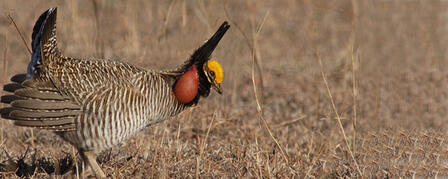KDWPT FINDS LESSER PRAIRIE CHICKENS OUTSIDE CURRENT RANGE

Computer modeling system reveals previously unknown breeding grounds
PRATT — The Kansas Department of Wildlife, Parks and Tourism (KDWPT) recently used Maximum Entropy (MaxEnt) modeling software to target searches for lesser prairie chicken leks (breeding grounds) outside their current range in northwest Kansas. MaxEnt modeling can identify areas with a high probability of lek occurrence by analyzing presence-only data (not absence data), making it an ideal method for analyzing lek survey data.
"We used MaxEnt to identify areas that had a relatively high probability of occurrence outside the lesser’s known range and targeted those areas to survey," says Jim Pitman, small game coordinator for KDWPT. "Finding chickens outside the known range allows us to more accurately delineate the range and better target conservation programs to ensure they are being implemented in areas where chickens have the best chance to benefit."
The targeted surveys were successful in locating new lek sites and resulted in KDWPT extending the historic lesser prairie chicken range 30 miles north. Despite high winds making it difficult to detect leks, the biologists found both lesser and greater prairie chickens and greater/lesser prairie chicken hybrids, called "guessers," present on 11 leks well outside the current known range of the species. They also located 23 leks occupied solely by greater prairie chickens and three leks in which species composition could not be identified.
To determine the probability of lek occurrence, the MaxEnt model compares a given set of landscape characteristics at known lek sites to areas where lek occurrence is unknown. The landscape characteristics include features that could influence lek site selection by the lesser prairie chicken, such as vegetation type, anthropogenic features, and elevation. The results showed that both biological type — such as vegetation — and anthropogenic features — such as highways — were important in predicting where leks occur.
To identify areas for new lek surveys, the MaxEnt results were filtered to include only areas with a high probability of lek occurrence that overlapped native grassland or CRP in Ellis, Trego, Graham, Sheridan, Rawlins, and Thomas counties. These high-probability areas were then connected creating 15- to 20-mile routes that biologists could search.
Historically, the lesser prairie chicken was found throughout western Kansas, but over time its range receded due to habitat loss and degradation. The federal Conservation Reserve Program is given much credit for the species’ apparent stability in western Kansas, and the new software model is helping identify the extent of that stability, or perhaps even growth.
"MaxEnt is working really well, and we feel comfortable that this model is doing a good job of predicting where lessers occur," Pitman explains. "Since we don’t have the manpower to survey every square inch of potential range, MaxEnt will be very useful for targeting our surveys, and most importantly, conservation programs in the future."
Because of the success of the KDWPT MaxEnt model, the Western Governors Association (WGA) is supporting state wildlife agencies from Kansas, Oklahoma, Texas, New Mexico, and Colorado in developing a range-wide lesser prairie chicken support system that incorporates MaxEnt modeling results, along with other products.
-30-









